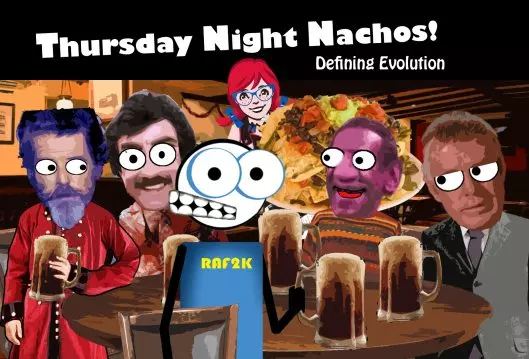The video above will sum up the key points of this chapter- in this case, the problems with Vestigial Organs as proposed mechanisms of Evolution. The full chapter, which features Rent-A-Friend and his fellow Nacho-eating arm chair philosophers, can be read below. Enjoy! #JesusLovesYou
To read other parts of this series click here
Another Thursday had come and gone, and we had fought our way valiantly through meetings, paperwork, and office coffee. We had scaled the cubical walls in marketing department sieges and taken many prisoners in the form of sticky notes and ball-point pens. We had worked through lunch with only some microwaved left-overs to sustain us, and we came to Danny’s Bar, Grill, and House of Rabblerousing anxious for our enormous pile of Nachos.
Despite our hunger for Nachos, we also came with a hunger for science, though of a metaphorical kind. We didn’t intend to eat any science. But I suspect you knew that.
A few weeks back I had presented the world, including my four friends around the round table by the dart board, with the very first clear and very useful definition for Darwinian Evolution, and had since been using that definition to examine the various proposed mechanisms of Darwinian Evolution. On this night, Carl had come with what he felt was a sure fire nail in the coffin for my denial of Darwin, and launched right into it as soon as each of our hands held a frosty root beer.
“I’ve got something which I think will change your tune,” Carl said, implying my personal tune. “As you have said many times, science is based on observation, and so I have a mechanism of evolutionary change which is easily observable in the present- even in our own bodies.”
“If we need to look into one of our bodies,” said Captain Blue Beard, “my cutlass is out in the truck. And I volunteer Tom to be cut open.”
“Hey now!” objected Tom.
“Nothing against ya, Lad,” explained Blue Beard, “but Carl is the one doing the explaining, so he needs to be in one piece, Bill is the doctor, so he’d need to assist with the cutting, and Rent-A-Friend tends to be a real whiner about these things.”
“No one is getting cut open,” I insisted. I was upset, but the fact is, he was right. I tend to be a whiner when it comes to being cut open with a cutlass. I don’t think that makes me less of a man, but we all have our peculiarities.
“I meant,” clarified Carl, “that we can learn about evolution from the inner workings of the human body. Our bodies, and many other organisms show evidence of evolution because of the existence of vestigial organs.” He smiled smugly. “Do I need to explain vestigial to anyone?”
“For Pete’s sake,” said Blue Bleard, “of course we know what vestigial is. They’s the parts of a sleeveless upper body garment.” He looked around for moral support and instead saw four of his friends wide eyed, waiting for a punch line. “That’s not it then?”
“No, you sea faring flea circus,” said Carl. “A vestigial structure, and this definition is strait from the UC Berkley Evolution web site*, is a feature that was an adaptation for the organism’s ancestor, but that evolved to be non-functional because the organism’s environment changed.”
“Evolved to be non-functional!” I said with a laugh. “How’s that for New-Speak? Now something formerly useful becoming useless is evolution. Those guys could do spin for the White House and report how great the economy has become since so many persons formerly burdened with employment have been promoted to a home based, unscheduled, non-for profit position.”
“I figured you’d be quick to reject even something so observable in defense of your religion,” said Carl with a sneer. “But let’s face the facts. We see vestigial organs and structures in lots of living things. There are fish living in caves whose ancestors had eyes, and because of natural selection, the cave fish no longer do. That’s a genetic change over time which has lead to a new species. Furthermore, even the human body has vestigial structures, unless you want to claim that God made useless organs like the appendix, whose only functions seem to be getting infected and needing to be removed.”
“So, Carl,” I said, “let’s clarify. Vestigial organs are organs or other structures which, we suppose, USED to do something, but now don’t, or even more drastic, have been lost entirely.”
“That’s right,” he said. “Evolution has taken away function and structure, showing a change through time. Decent with modification.”
“Change over time and decent with modification,” I repeated, “both of which are definitions for Evolution we’ve already seen to be intellectual failures.”
“I don’t know if you failed math back in grade school,” said Blue Beard, “but losing something a little or a lot doesn’t MAKE anything NEW. You can’t ADD by SUBTRACTING!”
“Our pirate pal is right again,” I said. “Nothing which exists does so merely because something else stopped existing. Thus, this is NOT evolution, and at this point I start to wonder why evolutionists bring it up. It really seems like grasping at straws.”
“You guys are just upset that I have found observable scientific evidence of evolution having happened,” said Carl. “You tell me, did the appendix have a use in our evolutionary past, or did God make some junk that doesn’t do anything but cause us to need surgery to remove it?”
“Carl,” I said with wonder, “you are the king of logical fallacies- or, what I like to call Flawgical thinking.”
“Name calling doesn’t change the facts,” replied Carl.
“Not name calling, my friend,” I said. “However, you have presented a classic false dichotomy.”
“What’s a false dichotomy?” asked Tom.
“It simply means,” I explained, “that he has presented two options as the only two options when there are in fact more options.”
“What other options?” demanded Carl.
“The first one you didn’t think of is, maybe God created it with a function which it has since lost. Just because something is malfunctioning today, doesn’t prove God made it that way.”
“I was thinking the same thing,” said Bill. “For example, the pancreas, you know, can stop making insulin. And if it does, you see, you become diabetic. But that doesn’t show that the pancreas had no purpose when it was made. It shows that the world has been falling apart like Blue Beard’s pick up truck.”
“Now, now,” said Blue Beard, winking at Carl. “I figure if my truck loses enough parts it will become one of those fancy hybrids I keep hearing about!”
“Well, fine!” said Carl, unimpressed. “If you want to believe that God exists and He made everything, then you can pretend it’s possible that the appendix did have a function, but I was basing my options on things we can observe. That’s what science does.”
“In that case,” I replied, “you still should have one more option.”
“What option?”
“The Appendix DOES have a function,” I said. “It’s not vestigial at all. Like the dozens of other alleged vestigial organs in the human body we now know the uses of, it has a function because we were designed by a brilliant designer.”
“Ridiculous!” said Carl. “Everyone knows that the Appendix is a vestigial organ which doesn’t do anything in the human body! I’ve got a college biology textbook which says so!”
“I don’t doubt it,” I said. “I’ve got one as well. But I’ve also got two quotes on the subject which show how unreliable textbooks can be. The first comes from in the October, 2010 issue of Natural Geographic, in an article called Vestigial Organs Not So Useless After All, Studies Find:
“The appendix, a narrow tube that hangs off one end of the colon, is probably the most famous “junk” organ. But it’s turned out to be important even today—in certain circumstances.”
“So maybe it does something,” said Carl with a shrug. “What does that prove? There are still lots of other vestigial organs.”
“First it proves that Evolution has been surfing a wave of ignorance and lies since the beginning,” I said.
“Just because a textbook doesn’t have the latest medical research,” said Carl with disdain, “doesn’t mean they are lying when they present the Appendix as Vestigial.”
“I thought you would say so,” I said, “and so I have a few more quotes on the subject:
“For at least 2,000 years, doctors have puzzled over the function of the thymus gland. Modern physicians came to regard it, like the appendix, as a useless, vestigial organ, which had lost its original purpose, if indeed it ever had one. In the last few years, however… men have proved that far from being useless, the thymus is really the master gland that regulates the intricate immunity system which protects us against infectious diseases… Recent experiments have lead researchers to believe that the appendix, tonsils and adenoids may also figure in the antibody responses.” *“The Useless Gland that Guards Our Health”, in Reader’s Digest, November 1966.
NINETEEN SIXTY SIX! That’s more than a decade before I was BORN! But wait! Look at the date on THIS ONE:
“There is no longer any justification for regarding the vermiform appendix as a vestigial structure .” * William Strauss, Quarterly Review of Biology (1947), p. 149.”
“1947!!!” exclaimed Blue Beard.
“That’s only, what? TWO YEARS after World War Two! Right?” said Tom.
“Did YOU hear this in high school?” I asked. “Because my textbook left this out and taught the EXACT OPPOSITE.”
Carl has nothing more to say on the subject, so I gathered from the fact that he had folded his arms and chosen to stare away from us toward the kitchen.
“How would we know something is Vestigial?” asked Tom.
“The process is simple,” I answered. “First we assume evolution is true. Then we assume that the organ or structure in question has no purpose now. Then we assume it had a purpose in the evolutionary past and has ‘evolved to be non-functional.’ Then some idiot creationist comes along and suggests that the structure HAS a function, like the appendix or spleen or tonsils or thymus or coccyx… and dang it he’s right. So we take those off of the list of vestigial items and keep on believing in evolution.”
Blue Beard laughed out loud, but Tom seemed uncertain.
“But what about those cave fish?” he asked. “Here, I found this,” he said pulling out a print out from his man bag, “on an evolutionary web site*.” He read the following to us,
“Fish species that live in completely dark caves have vestigial, non-functional eyes. When their sighted ancestors ended up living in caves, there was no longer any natural selection that maintained the function of the fishes’ eyes. So, fish with better sight no longer out-competed fish with worse sight. Today, these fish still have eyes — but they are not functional and are not an adaptation; they are just the by-products of the fishes’ evolutionary history.”
“This is a great example of something which could actually be argued to be vestigial,” I admitted. “If you remove the claim that this has anything to do with evolution, then I agree with this paragraph. It is an example of a non-functional organ which was previously functional- and is a kind of change we have witnessed within a few generations, thus making it observation based science. But there’s no bait and switch without the bait.
“The problem is THIS IS STILL A LOSS! These fish have LOST the use of their eyes. In fact, some studies show they still retain the information it took to make eyes, but those genes are switched off.”
“There are lots of examples of living things with genes that do not get used,” Bill added. “When the conditions are right, the genes can get switched back on. This is why pasty, colorless Europeans get tan when exposed to sunlight; the gene that produces melanin gets kicked on when they are exposed to lots of sun.”
“Hey!” said Blue Beard. “I resemble that remark.”
“Is that enough of a genetic change to be considered Evolution?” asked Tom.
“This is not evidence of evolution,” I said, “as evolution requires a GAIN OF GENETIC INFORMATION. Turning genes off is NOT evolution anymore than parking your car makes you Henry Ford. Discovering fish no longer have functional eyes tells us NOTHING about where the functional eyes had come from in the first place, and that is what Evolution is supposed to be able to explain.”
“And finding a gene has been switched off,” added Bill, “doesn’t do anything to prove the genes came about through unguided, natural processes.”
“I think its worse,” I said. “The fact that genes can be activated and deactivated by external pressures makes the genetics of life even more complex than we used to think. This doesn’t remove the need for an intelligent designer, it makes it all the more obvious.”
“Not to beat a dead horse,” said Blue Beard to Carl, “but how many parts of a fish you figure need to stop working before the fish becomes a lizard? Maybe next week I’ll bring a fish and a pair of scissors and we can find out?”
Carl offered no reply.
As our Nachos approached the table, I made the suggestion, “If we all work together to spread the word, I think we can educate even the writers of biology textbooks and National Geographic, and maybe, just maybe, they might change their tune. All they need is the truth. And fifty or sixty years.”
Wendy’s approach signaled the end of the conversation for the night, but not for good. We would not rest, I was certain, until we had looked under every metaphorical rock for the truth. In the mean time, we had Nachos to scale.
Happy Nachos! And thanks for letting me be your Rent-A-Friend.
*http://evolution.berkeley.edu







